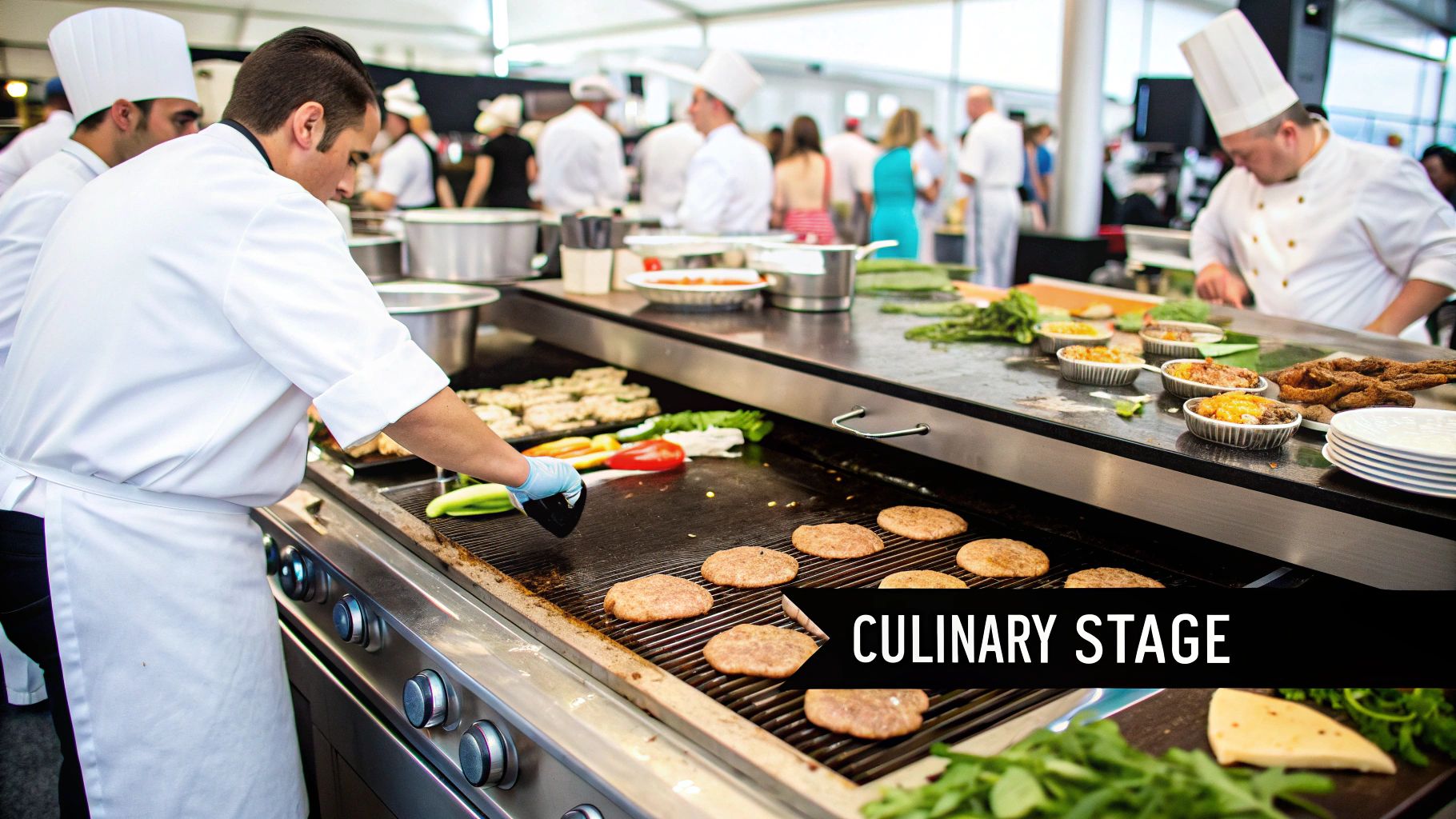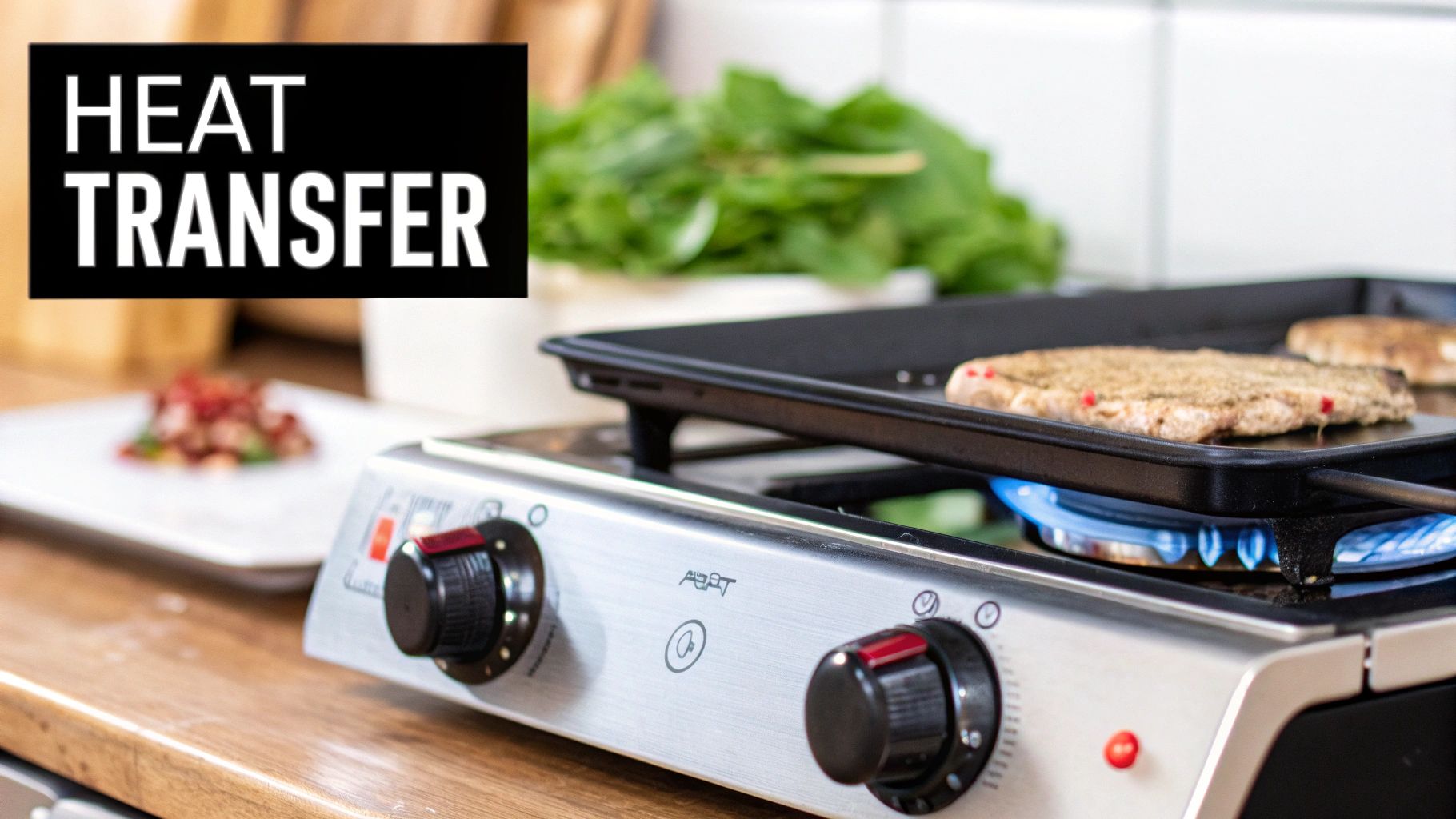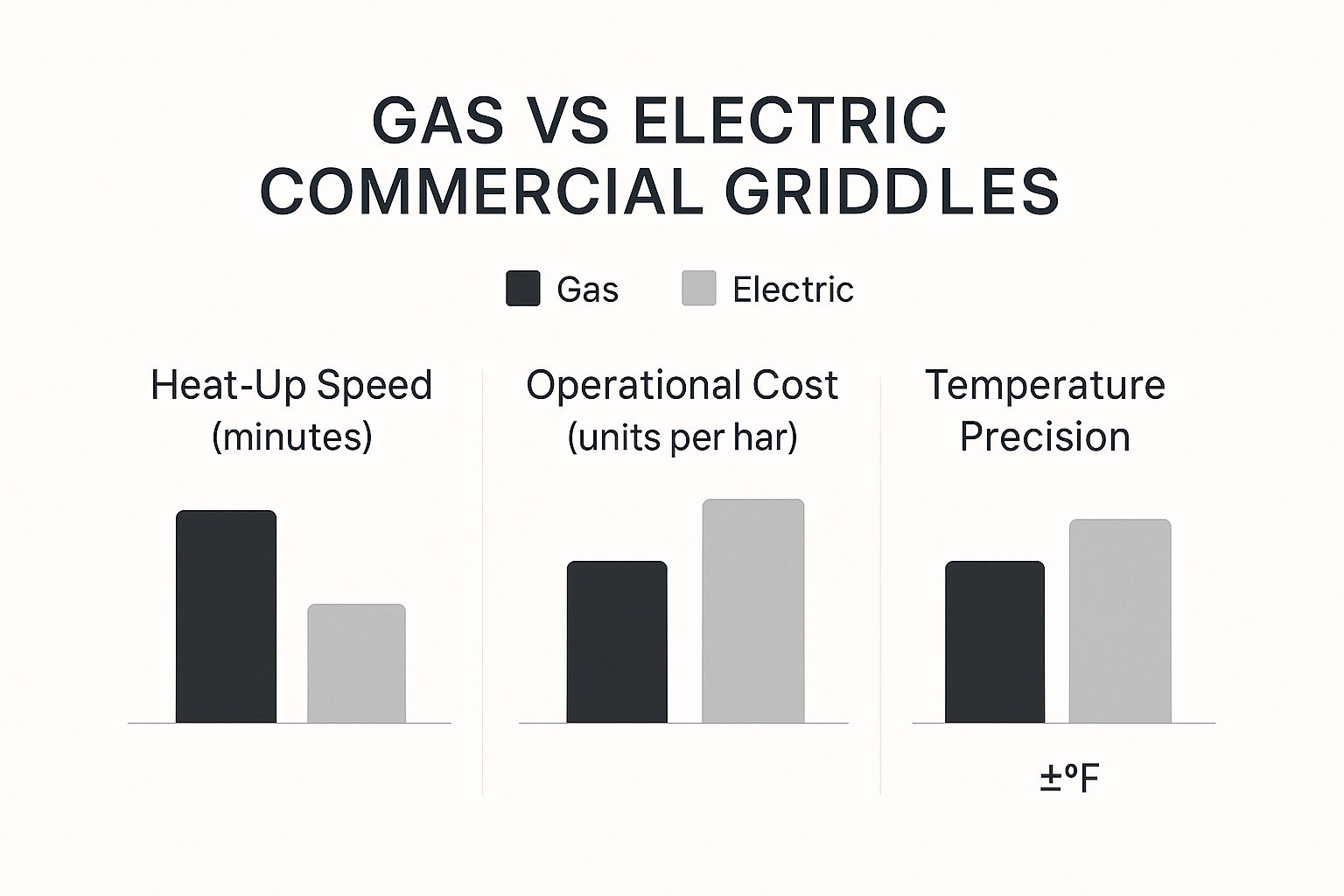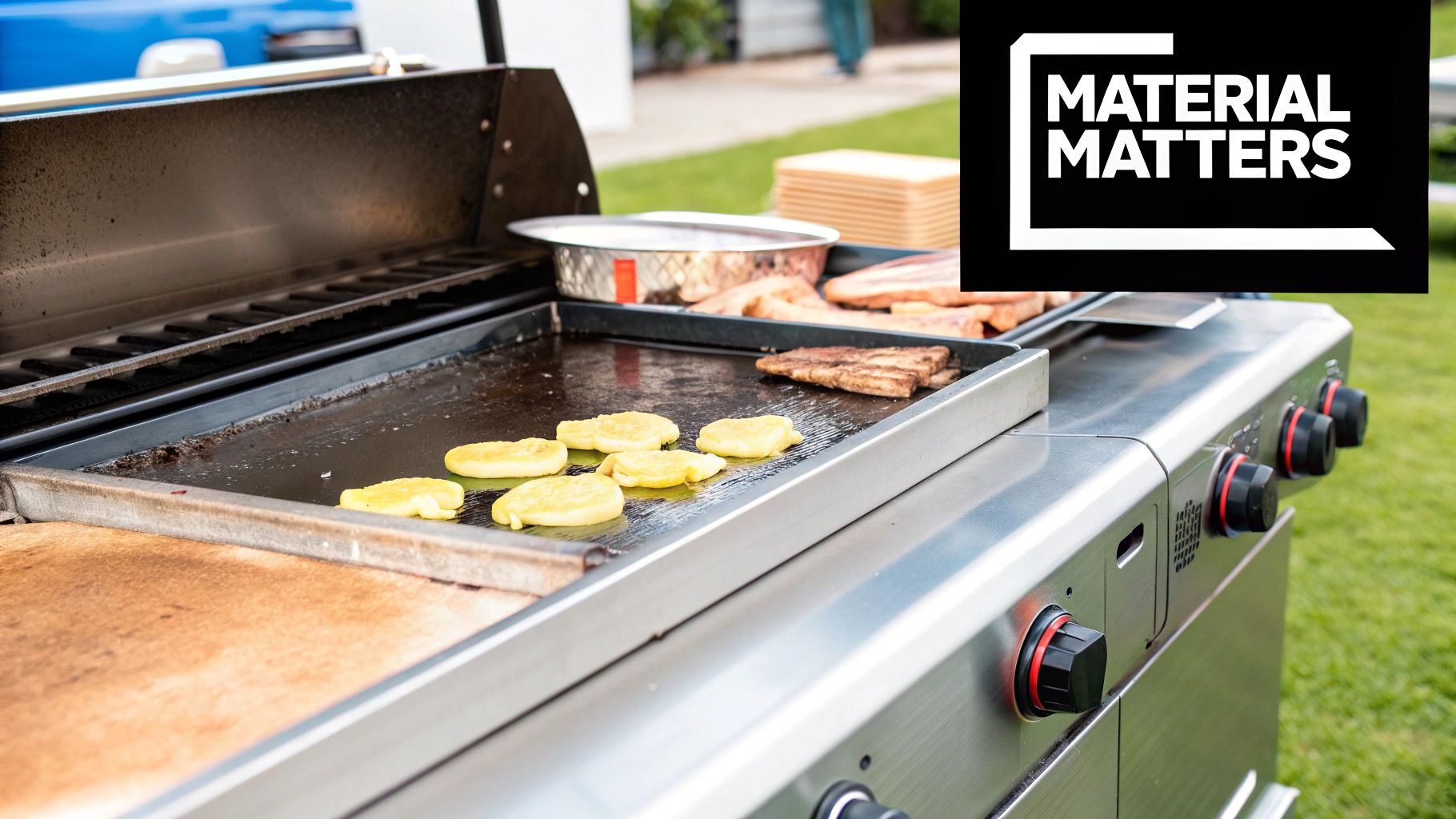
The Ultimate Guide to Commercial Griddles
If you've ever worked in a high-volume kitchen, you know the sound. The sizzle. The clatter of spatulas. Right at the center of that beautiful chaos, you'll almost always find the commercial griddle. It’s the unsung hero of the line, churning out everything from stacks of morning pancakes to perfectly seared burgers.
Think of it as the tireless workhorse of your culinary operation. Its job is simple but critical: provide a massive, flat, and evenly heated stage for cooking, letting your team crush the rush with consistent results.
The Role of Commercial Griddles in a Pro Kitchen

Step behind the counter of any bustling diner, food truck, or ghost kitchen, and you'll see the griddle is the heart of the action. It's more than just a piece of steel; it's a versatile platform where different ingredients can cook side-by-side, each getting the exact heat it needs to shine.
This one appliance is a master problem-solver. It dramatically expands your usable cooking real estate, allowing chefs to fire multiple orders at once without juggling a dozen different pans. During that peak dinner service, that space isn't just a luxury—it's everything.
Solving Key Kitchen Challenges
Another game-changer is the griddle’s rock-solid heat distribution. Forget the hot and cold spots you fight with on a standard range. A quality griddle holds a steady, reliable temperature across its entire surface. This means every single burger, pancake, and order of fajitas comes out perfect, every time. That consistency is what keeps customers coming back and keeps food costs down.
When you get right down to it, a commercial griddle tackles some of the biggest kitchen headaches:
- Wasted Space: It consolidates cooking onto one large surface, freeing up your burners for other tasks.
- Uneven Cooking: It delivers consistent heat, eliminating the guesswork and inconsistency of pans.
- Slow Ticket Times: It lets you cook in batches and handle multiple menu items at once, pushing food out faster.
A great griddle is basically a well-oiled assembly line for your food. It gives you that consistent foundation you need to produce high-quality dishes at speed—the lifeblood of any successful restaurant.
Ultimately, a commercial griddle is a foundational investment that directly boosts a kitchen's efficiency, consistency, and profitability. Figuring out its importance is the first step. Choosing the right model, whether it's a small countertop unit or a massive floor model, is what can truly change the game for your business. It becomes an indispensable partner in the daily grind.
Understanding How Commercial Griddles Work

When you boil it down, a commercial griddle has a beautifully simple job: give the chef a big, flat, consistently hot surface to cook on. That’s it. But that simple function is absolutely essential in a professional kitchen.
Think of it less like a stovetop burner and more like a massive, heated canvas. While a range makes you juggle a bunch of individual pans, a griddle offers one unified cooking zone where you can sear burgers, toast buns, and cook pancakes all at the same time.
It’s a different beast than other cooking equipment. A charbroiler uses direct flames to get that distinct smoky flavor. A range is your go-to for boiling water or simmering sauces in pots. The griddle’s superpower is its sheer surface area and steady, unwavering heat—perfect for anything that needs to be cooked directly on the steel.
The ability to hold a consistent temperature isn't just a nice-to-have; it's what makes the breakfast rush manageable. This principle of reliable temperature control is a cornerstone of the foodservice industry, driving demand for equipment that delivers steady, predictable heat for cooking and holding applications alike.
The Essential Components of a Griddle
To really get what makes a griddle tick, you need to look at its three main parts. Each one has a specific role, and they all work together to deliver the kind of performance a busy kitchen needs.
- The Griddle Plate: This is the star of the show. It’s the heavy-duty steel surface you cook on, and its main purpose is to soak up heat and spread it out evenly.
- The Heat Source: Tucked underneath the plate are either gas burners or electric heating elements. Gas is known for heating up fast and giving you quick temperature adjustments. Electric models are champs at maintaining a rock-solid, precise temperature.
- The Thermostat Controls: This is the brain of the operation. It tells the heat source when to fire up and when to back off, keeping the plate at the exact temperature you set. No more constant fiddling with knobs.
Heat Transfer and Plate Thickness
The real magic of a great griddle comes down to the physics of heat transfer, and the thickness of the plate is a huge part of that equation.
A thicker plate, say 1-inch thick, is like a thermal battery. It stores a ton of heat energy. So when you slap a dozen cold burger patties onto it, the surface temperature barely dips.
This excellent heat retention is what gives a griddle a fast "recovery time." It bounces back to its target temperature almost instantly after you load it with cold food, which means the first pancake cooks just as perfectly as the last.
Thinner plates, on the other hand, heat up quicker but also lose that heat just as fast. During a chaotic lunch service, that can lead to inconsistent cooking and longer wait times. If you really want to dig into the details of temperature regulation, you can learn more about how a thermostatic griddle gives you pinpoint control.
Comparing Different Types of Commercial Griddles
Picking the right commercial griddle isn't a one-size-fits-all kind of deal. The best unit for you really boils down to what your kitchen needs—from the food you’re cranking out and how much of it, all the way to your utility hookups. The first big fork in the road is usually the power source: gas or electric. Each one brings its own strengths to the line.
Ask any seasoned line cook, and they'll tell you gas griddles are beasts when it comes to raw power and speed. They heat up in a flash, letting you get right to it. That responsive flame gives you incredible control, making it easy to dial the temperature up or down on the fly during a chaotic dinner rush.
On the flip side, electric griddles are the masters of precision. They hold a steady, even temperature across the entire cooktop with almost no fluctuation. This is a game-changer when you're working with delicate items like fish or pancakes that demand consistent heat.
This infographic breaks down those key differences, showing how gas and electric models stack up on heat-up speed, running costs, and temperature accuracy.

As you can see, it's a classic trade-off. Gas gets you up and running faster, but electric delivers that rock-solid temperature control. It all comes down to what you value more: speed or pinpoint accuracy.
Gas vs Electric: The Big Decision
Deciding between gas and electric often comes down to what your kitchen is already set up for and what your menu looks like.
Gas griddles are the workhorses of high-volume kitchens for a reason. They offer pure, unadulterated power and recover their temperature quickly, even when you're slamming down pounds of cold food. These units can run on either natural gas or propane, each with its own benefits. If you're weighing your fuel options, it's worth exploring the differences between natural gas vs propane to see which fits your operation.
Electric models, however, are in a league of their own where precision is the name of the game. Picture a bistro that needs to perfectly sear scallops or an upscale breakfast spot that prides itself on flawless omelets. Electric provides that edge-to-edge consistency, wiping out the hot spots that can plague other griddles. They might take a bit longer to get up to temp, but their stability during service is a huge win for certain menus.
Exploring Different Griddle Configurations
Once you've settled on a power source, the next step is choosing the right physical setup for your space and workflow. Commercial griddles come in a few common shapes and sizes.
-
Countertop Griddles: These are the most popular kids on the block for a good reason—they're incredibly versatile. These compact units can sit right on a refrigerated chef base or a stainless steel work table, making them a perfect fit for kitchens tight on floor space, food trucks, or concession stands.
-
Drop-In Griddles: For that clean, built-in look, a drop-in model is the way to go. These are installed directly into your countertop, creating a seamless surface. It's an awesome choice for front-of-house cooking stations, like at a hotel breakfast bar or a high-end buffet line where presentation matters.
-
Teppanyaki Griddles: Built specifically for Japanese-style cooking, these griddles are all about performance and showmanship. They're often used right in front of customers, turning the cooking process into part of the dining experience. A polished finish and reliable, even heat are non-negotiable here.
Your griddle's configuration should enhance your kitchen's flow, not hinder it. A well-placed countertop unit can become the central hub of a busy line, while a drop-in model can elevate a customer-facing cooking station.
At the end of the day, the perfect griddle is a combination of the right power source and the right physical form. A bustling diner might need a big gas countertop unit to handle the morning rush, while a small cafe could do wonders with a compact electric model for its precision and smaller footprint. Matching the equipment to the job is how you get the most bang for your buck.
Key Features and Materials to Look For

When you’re trying to pick out a new commercial griddle, the spec sheet can feel pretty overwhelming. But knowing what a few key terms mean is the difference between buying a true kitchen workhorse and a piece of equipment that gives you nothing but headaches. The most important part, by far, is the griddle plate itself—its material and thickness will determine everything from heat-up times to how you clean it.
Polished steel is the industry standard for a reason. This material is a beast when it comes to even heating and pure toughness, built to take the punishment of a busy kitchen day in and day out. It's a solid, all-around performer you can count on for searing, frying, and just about anything else you throw at it.
On the flip side, you've got griddles with a chrome top. This finish gives you an almost non-stick surface, which is a game-changer for delicate foods like eggs, pancakes, or fish. It also makes cleanup worlds easier, since burnt-on food slides right off with barely any scraping.
This need for reliable, hard-working equipment is what drives the whole foodservice industry. Demand for durable and efficient cooking equipment continues to grow as kitchens seek gear that won't let them down during peak service.
Plate Thickness and Control Systems
Look past the shiny surface and you’ll see another critical detail: plate thickness. A standard 1-inch thick plate is like a thermal battery; it soaks up and holds a ton of heat. That means when you slam a dozen cold burger patties onto it, the surface temperature snaps back almost instantly. You get consistent cooking from the first order to the last.
Next up, you have to decide on the control system. You’ll generally run into two types:
- Thermostatic Controls: These are the most popular because they give you pinpoint temperature control. You set it to 350°F, and the griddle keeps it at 350°F, turning the burners on and off as needed. Simple as that.
- Manual Controls: These are your basic high, medium, and low settings. They aren't as precise, but they are incredibly durable and easy to use, which makes them a great pick for kitchens with straightforward menus.
Think of a thick griddle plate with thermostatic controls as your insurance policy for the dinner rush. It guarantees consistent, predictable results, no matter how busy the line gets.
Essential Design and Build Quality
Finally, check out the little things that make life in the kitchen easier. A good grease management system is absolutely non-negotiable. You want a wide grease trough and a big drip tray that’s easy to pull out and empty. Splash guards around the back and sides are also a must to keep grease off your walls and other equipment.
Of course, to keep your whole station running smoothly, it helps to understand how different pieces of equipment complement your griddle workflow.
Look for a griddle with solid, stainless steel construction. It's the only way to ensure it will survive the daily grind of a professional kitchen. Once you know how to read these key specs, you're ready to invest in a machine that will actually work for you, not against you.
How to Choose the Right Griddle for Your Business
Picking out the right commercial griddle isn’t just about getting the biggest or most powerful model on the market. It’s a strategic move. You're finding a piece of equipment that slots perfectly into your kitchen's daily grind. After all, the griddle a high-volume diner needs to sling hundreds of pancakes is totally different from what a ghost kitchen needs for its ever-changing menu.
To get it right, you have to look past the spec sheet and get real about your day-to-day operations.
Imagine a busy breakfast joint on a Saturday morning. They’ll likely lean toward a gas griddle with a thick, 1-inch steel plate. Why? That thick plate is like a thermal battery. It holds an incredible amount of heat, recovering its temperature almost instantly after you slap down a bunch of cold ingredients. No more bogging down during the morning rush.
Now, picture a ghost kitchen running three different concepts from one line. They'd probably go for an electric model with multiple thermostatic controls. That setup gives them precise, independent cooking zones. The chef can get a perfect sear on a steak on one side while gently cooking down some onions on the other. It’s that kind of flexibility that keeps a modern kitchen humming.
Key Questions to Guide Your Decision
To nail down the perfect griddle, you need to ask yourself a few tough questions about your operation. Your answers will create a roadmap that points directly to the machine that will make your life easier, not harder.
Think of it as your pre-purchase checklist:
- What's on Your Menu? Are you cranking out classic breakfast fare like bacon and eggs, or do you need pinpoint temperature control for delicate fish? What you cook determines the surface and controls you need.
- What is Your Peak Volume? Be brutally honest about your busiest hour. A high-volume spot can't compromise—it needs a thick plate for rapid recovery to keep tickets moving.
- How Much Space Do You Have? Kitchen real estate is gold. Can a compact countertop unit get the job done, or do you have the room and the need for a bigger freestanding model?
- What is Your Budget? The sticker price is only part of the story. Don't forget to factor in long-term costs like energy use and maintenance. A slightly more expensive but rock-solid griddle often pays for itself in the long run.
When you match a griddle's features to your operational reality, you're not just buying equipment. You’re making a smart investment that will pay you back every single shift in speed and quality.
The rise of cloud kitchens and delivery-only concepts has really put a spotlight on having specialized, efficient gear. This isn't just a griddle thing; it’s happening across the board. The demand for smart, reliable equipment is reshaping how modern kitchens are designed and equipped to handle high-volume and diverse menus.
Ultimately, choosing the right griddle is all about matching the machine to the mission. If you think hard about your menu, volume, space, and budget, you'll end up with a workhorse that becomes the backbone of your kitchen for years.
Common Questions About Commercial Griddles
Even the most experienced chefs run into questions when trying to wring every last bit of performance out of their commercial griddles. These flattops are the heart of the line, but knowing a few key tricks can be the difference between a good service and a great one. Let's dig into some of the questions we hear all the time.
Getting the care and usage right doesn't just make your griddle last longer—it has a direct impact on the quality of the food coming off it. From the moment it's unboxed to the final wipe-down of the night, mastering these basics is a must.
How Do You Properly Season a New Griddle?
Seasoning is that all-important first step that turns a fresh-out-of-the-box griddle from a boring slab of steel into a slick, naturally non-stick workhorse. You're essentially creating a protective, polymerized layer of oil that bonds directly to the metal.
It's a simple process, but you can't rush it:
- Start Fresh: Give the new griddle a good wash with warm, soapy water to get rid of any factory oils or dust. Dry it completely.
- Oil It Up: Drizzle a little bit of high-smoke-point oil (canola or vegetable oil works great) onto the surface. Grab a clean cloth and spread a super-thin, even coat across the entire cooktop.
- Bring the Heat: Fire up the griddle to medium-high, somewhere in the 350-400°F range. Let the oil cook until it starts to smoke.
- Cool Down, Repeat: Once the smoking stops, kill the heat and let the griddle cool. Wipe off any gummy excess oil and then do the whole thing over again, two or three more times. You'll see the surface start to darken—that's the sign of a job well done.
That first seasoning lays the foundation. From there, it just gets better every time you cook.
What Is the Best Way to Clean a Griddle?
Daily cleaning is non-negotiable. It's about hygiene, sure, but it's also about performance. The trick is to scrape off the gunk and grease without destroying that beautiful seasoning you worked so hard to build up. The perfect time to clean is when the griddle is still warm, but not ripping hot.
Use a griddle scraper to push all the leftover food bits and grease into the trap. If you've got some stubborn, caked-on spots, pour a little warm water or club soda on the hot surface; the sizzle and steam will lift it right off. Finish with a quick wipe-down and a tiny bit of fresh oil to protect the surface from rust. And the golden rule: Never, ever use harsh soaps or steel wool. They will absolutely wreck your seasoning.
Can You Use Different Temperature Zones?
You bet, and that's where a griddle really shines. Most commercial griddles over 24 inches wide have multiple thermostat controls for a reason. They're designed to let you create different temperature zones across the flattop.
Think of it as having several pans built into one surface. You can be searing burgers on high heat on the left, toasting buns over gentle medium heat in the middle, and holding cooked bacon in a warm zone on the right.
This is the kind of control that lets a line cook pump out complex orders without missing a beat during the dinner rush.
What Is the Ideal Griddle Plate Thickness?
The thickness of the steel plate is a huge deal—it determines how well the griddle holds heat and how fast it bounces back after you throw down a bunch of cold food. There's no single "best" answer here; it all comes down to your menu and how busy you get.
- 1/2-Inch Plates: These heat up fast, but they lose their heat just as quickly. They're a decent choice for light-duty work or menus where you aren't constantly slamming the surface with frozen patties.
- 3/4-Inch Plates: This is the sweet spot for a lot of restaurants. It offers a nice balance, heating up reasonably fast while still having enough mass to hold its temperature pretty well.
- 1-Inch Plates: For high-volume kitchens, this is the undisputed champ. A heavy-duty 1-inch plate is like a thermal battery; it stores an incredible amount of heat and recovers almost instantly. It delivers consistent cooking temperatures even when you're in the weeds.
For most classic diners, breakfast joints, and burger spots, that thick 1-inch plate is the gold standard for a reason. It’s a true workhorse.
Ready to find the perfect workhorse for your kitchen? The experts at Griddles.com can help you select a commercial griddle that matches your menu, volume, and budget, ensuring you get a reliable machine built to last. Explore our collection of commercial griddles at Griddles.com.
